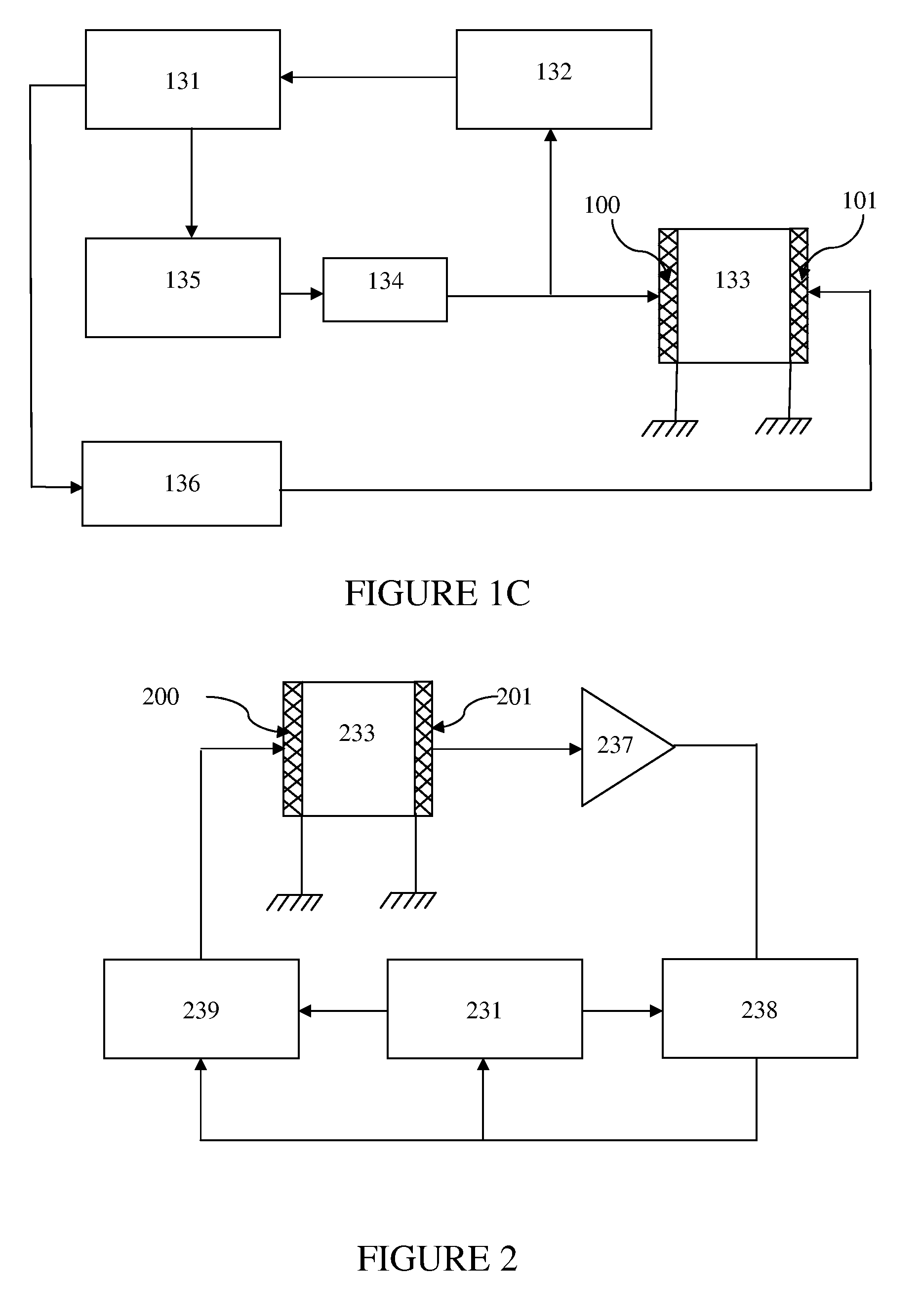Apparatus for ultrasonic stirring of liquids in small volumes
a technology of contactless stirring and apparatus, which is applied in the direction of mixing, chemistry apparatus and processes, mixers, etc., can solve the problems of difficult stirring and mixing in small volumes, ineffective application of conventional mixing strategies to microfluidic volumes, and tedious multi-step process of fabrication, etc., to achieve rapid and effective stirring of liquids
- Summary
- Abstract
- Description
- Claims
- Application Information
AI Technical Summary
Benefits of technology
Problems solved by technology
Method used
Image
Examples
first embodiment
[0048]Referring to FIG. 1A, there is shown a block-diagram of the device according to the invention. The device includes a transducer 100 that generates ultrasonic standing waves at various harmonics in the liquid filling the resonator cell 133. The resonator cell 133 can be formed between the liquid-contacting surface of the transducer 100 and a plane-parallel acoustic reflector 180 located opposite the transducer 100 so that ultrasonic wave may travel back and forth forming standing waves at certain resonance frequencies of the liquid column above the transducer. The transducer 100 is typically a disc, plate or a film made of piezoceramics, piezopolymer, or other material that can generate acoustic waves under alternating current excitation. The resonator cell 133 could be also formed by a vessel of arbitrary internal shape as long as its walls provide effective reflection of acoustic waves, creating at certain frequencies the nodes of standing waves in the liquid filling the vess...
second embodiment
[0060]FIG. 2 shows a schematic block-diagram of the invention. In the device according to this embodiment of the invention, an ultrasonic resonator cell 233 is formed by two plane-parallel piezotransducers 200 and 201 and is connected to a simple oscillation and feedback control system, including a broadband amplifier 237, a phase-locked loop chip 238, a microprocessor 231 and a bandpass filter 239. The transducer 201 serves both as a reflector and a receiver of ultrasound. FIG. 3 shows frequency dependencies of amplitude and phase of the signal at the receiving transducer 201 in a frequency band covering several resonance harmonics fn−1, fn, and fn+−1. The phase of the signal from the receiving transducer 201 is changed by 180° when the frequency is swept through a region corresponding to a resonance peak marked by bold lines on the frequency axis of the graph of FIG. 3. As seen in FIG. 3, the inflection point of the phase / frequency curve corresponds to the maximum of the resonance...
third embodiment
[0063]FIG. 4 illustrates an implementation of the resonator cell according to the invention. This design is particularly useful to facilitate mixing of two or more liquids using magnetic microbeads in a flow-through device for microfluidic applications. In the illustrated arrangement, the two liquids being mixed are supplied from different inlets 310 and 320 leading into a resonator cell 333. Some magnetic microbeads 340 are also fed into the resonator cell 333 along with the mixing liquids. Magnetic microbeads, such as for example micron-scale particles, are used in a variety of biotechnology applications, most notably for cell sorting and assay separations [as described in Choi, J.-W., C. H. Ahn, S. Bhansali, and H. T. Henderson. A new magnetic bead-based, filterless bio-separator with planar electromagnet surfaces for integrated bio-detection systems. Sens. Actuators B Chem. 2000, 68:34-39]. Magnetic microbeads are commercially available from numerous commercial sources and are c...
PUM
 Login to View More
Login to View More Abstract
Description
Claims
Application Information
 Login to View More
Login to View More - R&D
- Intellectual Property
- Life Sciences
- Materials
- Tech Scout
- Unparalleled Data Quality
- Higher Quality Content
- 60% Fewer Hallucinations
Browse by: Latest US Patents, China's latest patents, Technical Efficacy Thesaurus, Application Domain, Technology Topic, Popular Technical Reports.
© 2025 PatSnap. All rights reserved.Legal|Privacy policy|Modern Slavery Act Transparency Statement|Sitemap|About US| Contact US: help@patsnap.com



